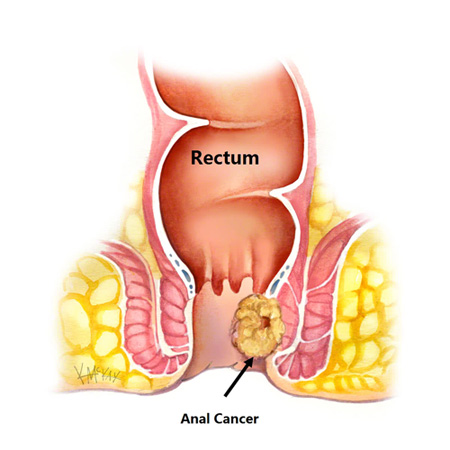The anal canal is defined as the terminal part of the large intestine, beginning at the upper surface of the anorectal ring and passing through the pelvic floor to end at the anus.
The most frequent neoplams of this region are HPV-associated squamous cell carcinomas (SCC) and adenocarcinomas.
In most settings, SCC compromises more than 70% of cases. In the general population, anal cancer is uncommon, with age-standardized incidence rates mostly between 1 and 2 per 100000 per year. However, the incidence of anal SCC is increasing by 1-3% per year in developed country settings. High-risk HPV types can be detected in 80-90% of all anal SCC cases, making it second only to cervical cancer in the closeness of its association with this virus.

The Risk Factors
• HPV infection with high risk genotypes
• Cervical dysplasia, cervical cancer, or genital warts
• HIV seropositivity and low CD 4 count
• Cigarette smoking
• Anoreceptive intercourse
• Immune suppresion following transplant (100x increase in KTX)
Clinical Presentation
• Rectal bleeding- 45% of patients
• Pain or sensation of mass- 30%
• No symptoms- 20%
• Pruritus ani or bleeding plaques associated with anal margin skin cancers- Paget’s disease
The Diagnostic Workup
• Physical exam- rectal and nodes
• Biopsy- used to differentiate squamous cell (anal ca) from adenocarcinoma (rectal ca) does not have to be excisional
• CT scan to evaluate for metastatic disease
• EUS to evaluate for sphincter involvement and perianal lymph nodes
• PET scan since 25% of patients have metastatic disease by PET not seen on CT and 20% of inguinal nodes negative by CT are PET positive.
Treatment
Planning of the treatment involves an inter-disciplinary team of medical professionals.
The treatment will usually combine intervention methods that:
• Act on the cancer locally, such as surgery or radiotherapy
• Act on cancer cells all over the body by systemic therapy such as chemotherapy
Surgery:
The main goal of treatment is to obtain a cure with locoregional control, concomitant with the preservation of anal sphincter function and maintaining the best possible quality of life.
1) Squamous cell Carcinoma:
SCC represents the majority of anal canal tumors (85%). Initially, up to the 1980s surgery was the treatment for all anal carcinomas, mainly with abdominoperineal resection (APR) with 5 years survival rates achieved for 38-71% of patients and recurrence developing is 27-43%.
But now,the standard treatment for non-metastatic squamous cell carcinoma of the anal canal has been a combination therapy, with chemotherapy and radiotherapy with a radiation providing a complete regression in 80–90% of patients. Approximately, 15% of patients will have persistent disease initially while a further 15% will develop late locoregional recurrence. The 5 years survival figures of 60-80%, along with an 80% preservation of anal function, makes non-surgical management an attractive option for anal canal tumors.
Surgery (abdominoperineal resection and permanent colostomy) in SCC is reserved for patients with residual or recurrent disease after a complete treatment of chemo radiotherapy.
Surgery after recurrence allows a local control in 60% of cases and a survival at 5 years of 30–60%
2) Adenocarcinoma :
Adenocarcinoma of the anal canal are rare tumors (15%) and are thought to arise in the ducts or the intramuscular anal glands, and in the long-standing fistulas. These neoplasm affect older age groups and have no sexual predominance. Most of these lesions are slow growing, locally aggressive, and rarely metastasize. The abundant mucin production of these tumors may explain their tendency to dissect soft tissue planes. A wide local excision may be performed for small and well-differentiated carcinomas that have not invaded sphincter mechanism. Otherwise, APR is indicated.
3) Melanoma :
The anal canal is the third most common site of melanoma, exceeded only by the skin and the eyes, representing 0.3-1.6% of all melanomas. The mean age of occurrence is in the fifth decade, and females are affected more frequently than males. Surgery provides the only hope for cure, but significance differences in survival between patients treated with local excision and those with APR have not been demonstrated. However, APR seems to provide better local control of the disease. Unfortunately, local recurrence in these cases was often accompanied by the appearance of distal or regional metastases as well. Radio-chemotherapy has demonstrated little benefit in this disease. Patients treated in a curative fashion have a survival of 6-20%.
Treatment of Locally Recurrent and Metastatic Disease with Chemotherapy:
Different regimens of salvage chemotherapy may be used for metastatic anal carcinoma, although the most common regimens at present employ Cisplatin and 5-FU.4


